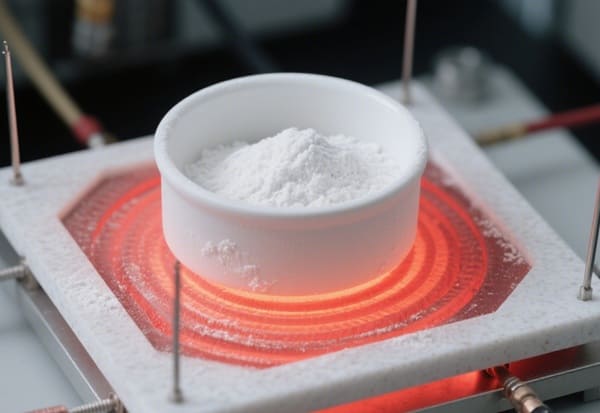Ceramic Crucible Temperature Guide: Maximum Limits & Safe Operating Range
Ceramic crucibles are essential tools in high-temperature applications, including metallurgy, chemical synthesis, and materials science. Their ability to withstand extreme temperatures enables them to contain molten metals, salts, and other substances without contaminating the sample or degrading it. However, exceeding their temperature limits can lead to severe consequences—crucible cracking, structural failure, and even dangerous chemical reactions. This guide explores material-specific temperature ratings, safe operating windows, and best practices for managing thermal loads to extend crucible lifespan and ensure operational safety.
At Advanced Ceramic Hub, we specialize in high-quality ceramic crucible products, ensuring optimal performance for industrial and scientific applications.

What Are Ceramic Crucibles Made Of and Why Does It Affect Temperature Range?
The performance of a crucible is largely determined by its composition. Materials such as alumina, zirconia, magnesia, graphite, and silicon carbide offer different levels of thermal conductivity, chemical resistance, and melting points. Thermal conductivity affects how evenly heat is distributed, while porosity and grain structure influence resistance to thermal shock and mechanical stress.
Common Crucible Materials and Their Max Temperatures:
| Material | Max Temp (°C) | Melting Point (°C) | Best Use Cases |
| Alumina (Al₂O₃) | ~1750 | ~2050 | General lab use, metallurgy |
| Zirconia (ZrO₂) | ~2200 | ~2700 | Ultra-high-temp applications |
| Magnesia (MgO) | ~2000 | ~2800 | Refractory and metallurgy |
| Graphite | ~3000 | Sublimes at ~3650 | Vacuum furnaces, reducing atmospheres |
| Silicon Carbide | ~1500 | ~2730 | Metal casting, foundries |
Selecting the correct material based on your application’s temperature needs is the first step to safe and efficient crucible usage.
Explore our high-quality ceramic products.
What Is the Safe Operating Range for Each Crucible Type?
Every crucible has a “safe operating range” below its maximum temperature. Operating at or near the maximum limit frequently can introduce microcracks, grain structure weakening, and premature failure. Safety margins of 100–200°C below the max temperature are typically recommended.
Safe Operating Ranges (°C) by Material:
- Alumina: 1450–1700°C
- Zirconia: 1800–2100°C
- Magnesia: 1600–1900°C
- Graphite: 2400–2800°C (in inert atmospheres)
- Silicon Carbide: 1200–1400°C
Other factors like the furnace atmosphere (oxidizing vs. reducing), thermal cycling frequency, and the physical properties of the sample material can shift these safe ranges.
How Can You Prevent Thermal Shock and Temperature Failure?
Thermal shock occurs when a crucible is subjected to sudden temperature changes. This causes uneven expansion, which leads to internal stress and cracking. Wet crucibles, rapid heating or cooling, and inconsistent heating sources are major contributors.
Crucible Guide Tips to Avoid Thermal Shock:
- Preheat crucibles in incremental steps
- Never quench hot crucibles with liquids
- Let crucibles cool naturally
- Avoid placing cold materials into a hot crucible
- Use lids to reduce radiant energy loss
High-density crucibles like zirconia are particularly sensitive to thermal gradients, and extra caution is needed when handling them.
What Are the Signs That a Crucible Is Overheated or Compromised?
Recognizing the early signs of crucible degradation can prevent dangerous failures. Overheating, whether occasional or repeated, leaves visual and structural cues like cracking or discoloration.
Overheating Symptoms and Likely Causes:
| Symptom | Possible Cause | Recommended Action |
| Hairline Cracks | Thermal shock or overfiring | Replace crucible immediately |
| Surface Discoloration | Chemical reaction or overheating | Check compatibility & temp logs |
| Deformation | Exceeded structural limits | Switch to higher-grade material |
| Soft Spots | Exceeded sintering threshold | Reduce operating temp |
Schedule routine visual inspections and maintain logs of temperature cycles to manage wear and tear effectively.
What Heating and Cooling Rates Should Be Followed for Safety?
Controlling thermal ramp rates is essential to prevent cracking. Even if a crucible is rated for high temperatures, ramping up or down too quickly can compromise its structural integrity.
Crucible Guide Recommended Thermal Ramp Rates:
- < 5°C/min for alumina crucibles above 1500°C
- < 3°C/min for zirconia to prevent stress fractures
- Allow minimum 1-hour soak at mid-temp zones
- Avoid direct flame heating unless designed for it
- Cool down inside the furnace whenever possible
Using programmable kilns or electronic furnaces helps ensure that consistent, safe heating and cooling profiles are followed.
How Does Load Size Affect the Crucible’s Temperature Limits?
The size and type of material placed inside the crucible impact how heat is distributed. Heavy or dense samples can trap heat unevenly, leading to local hotspots that surpass the crucible’s rated temperature.
Load Impact on Crucible Temperature Behavior:
| Load Type | Effect on Temperature Handling | Safety Tip |
| Dense Metal Ingots | Higher thermal mass = slower heating | Increase soak time |
| Fine Powders | Risk of sintering | Moderate heating speed |
| Liquid Samples | May cause thermal gradients | Use an inert atmosphere or liner |
| Oxidizing Agents | May react at elevated temps | Use inert atmosphere or liner |
Always consider actual operating conditions rather than theoretical temperature limits.
Are All-Ceramic Crucibles Suitable for Repeated High-Temp Use?
Some ceramic crucibles are engineered for single use, while others can survive dozens of cycles. Over time, even the most robust crucibles degrade. Knowing when to discard or reuse is key.
Crucible Guide on Reuse vs. Single-Use:
- Reusable: Alumina, zirconia, magnesia (with proper care)
- Limited-use: Porcelain, low-density ceramics
- Replace if the surface glaze is disrupted
- Avoid reusing cracked crucibles
- Document use cycles per crucible batch
Instituting a crucible tracking system improves safety and cost-efficiency.
What Crucible Temperature Guidelines Do Standards Organizations Recommend?
There are several global standards and safety regulations that guide crucible temperature tolerances and usage conditions.
Crucible Guide – Relevant Temperature Standards:
| Standard Code | Organization | Coverage |
| ASTM C1171 | ASTM Intl. | High-temp ceramics testing |
| ISO 12677 | ISO | X-ray fusion, high-temp sample prep |
| DIN 51068 | German Institute | Ceramic thermal properties |
| OSHA 1910 Subpart Z | U.S. OSHA | Exposure limits for high-temp operations |
| SDS Documentation | Manufacturer | Temp ratings & chemical compatibility |
Reviewing datasheets and compliance documentation is a best practice before purchasing or operating any crucible.
Request a custom quote for ceramic crucible products.
FAQ
| Question | Answer |
| Can I use a crucible at its max rated temp? | No—stay 100–200°C below for safe operation. |
| How fast can I heat a ceramic crucible? | Ideally <5°C/min above 1200°C to avoid thermal shock. |
| Is it okay to reuse a slightly cracked crucible? | No—microcracks can cause catastrophic failure. |
| What’s the best cooling method? | Natural cooling inside the furnace is safest. |
| Do all crucibles tolerate the same temp range? | No—it depends entirely on the material. |
Conclusion
Temperature is the single most important parameter when it comes to selecting and operating ceramic crucibles. Running a crucible at or near its thermal limits without understanding the risks can shorten its life dramatically or cause catastrophic failure. A temperature-specific crucible guide allows users to make informed decisions about materials, operating conditions, and safety protocols. By respecting safe thermal ranges, using appropriate ramp rates, and adhering to standards, laboratories and industrial operations can improve results and reduce replacement costs.
Looking for high-quality ceramic crucible products? Contact us today!
